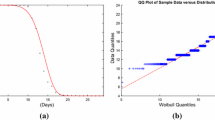Abstract
The continuous model of Anderson et al. (1981), Nature 289, 765–771, is successful in describing certain characteristics of rabies epizootics, in particular, the secondary recurrences which follow the initial outbreak; however, it also predicts the occurrence of exponentially small minima in the infected population, which would realistically imply extinction of the virus. Here we show that inclusion of a more realistic distribution of incubation times in the model can explain why extinction will not occur, and we give explicit parametric estimates for the minimum infected fox density which will occur in the model, in terms of the incubation time distribution.
Similar content being viewed by others
References
Abramowitz, M. and I. Stegun (1964). Handbook of Mathematical Functions, Washington, DC: National Bureau of Standards.
Anderson, R. M., H. C. Jackson, R. M. May and A. M. Smith (1981). Population dynamics of fox rabies in Europe. Nature 289, 765–771.
Artois, M., M. Langlais and C. Suppo (1997). Simulation of rabies control within an increasing fox population. Ecol. Modell. 97, 23–34.
Bacon, P. J. (Ed.) (1985a). Population Dynamics of Rabies in Wildlife, New York: Academic Press.
Bacon, P. J. (1985b). Discrete time temporal models of rabies, in Population Dynamics of Rabies in Wildlife, New York: Academic Press, pp. 147–196.
Baer, G. M. (Ed.) (1991). The Natural History of Rabies, 2nd edn, Boca Raton, FL: CRC Press.
Ball, F. G. (1985). Spatial models for the spread and control of rabies incorporating group size, in Population Dynamics of Rabies in Wildlife, P. J. Bacon (Ed.), New York: Academic Press, pp. 197–222.
Blancou, J., M. F. A. Aubert and M. Artois (1991). Fox rabies, in The Natural History of Rabies, 2nd edn, Boca Raton, FL: CRC Press, pp. 257–290.
British Medical Association, (1995). The BMA Guide to Rabies, Abingdon, Oxfordshire: Radcliffe Medical Press.
Durrett, R. and S. A. Levin (1994). The importance of being discrete (and spatial). Theor. Pop. Biol. 46, 363–394.
Fowler, A. C. and M. J. McGuinness (1982). A description of the Lorenz attractor at high Prandtl number. Physica D 5, 149–182.
Frauenthal, J. C. (1986). Analysis of age-structure models, in Mathematical Ecology, T. G. Hallam and S. A. Levin (Eds), Berlin: Springer-Verlag, pp. 117–147.
Grasman, J., H. Nijmeijer and E. J. M. Veling (1984). Singular perturbations and a mapping on an interval for the forced Van der Pol relaxation-oscillator. Physica D 13, 195–210.
Hoppensteadt, F. C. (1975). Mathematical Theories of Populations: Demographics, Genetics and Epidemics, Philadelphia: SIAM, (reprinted 1993).
Keeling, M. J. (1997). Modelling the persistence of measles. Trends Microbiol. 5, 513–518.
Keeling, M. J. and B. T. Grenfell (1997). Disease extinction and community size: modelling the persistence of measles. Science 275, 65–67.
Keeling, M. J. and B. T. Grenfell (1998). Effect of variability in infection period on the persistence and spatial spread of infectious diseases. Math. Biosci. 147, 207–226.
Macdonald, D. W. and D. R. Voigt (1985). The biological basis of rabies models, in Population Dynamics of Rabies in Wildlife, P. J. Bacon (Ed.), New York: Academic Press, pp. 71–108.
Mollison, D. (1984). Simplifying simple epidemic models. Nature 310, 224–225.
Mollison, D. (1991). Dependence of epidemic and population velocities on basic parameters. Math. Biosci. 107, 255–287.
Mollison, D. (Ed.) (1995). The structure of epidemic models, in Epidemic Models: Their Structure and Relation to Data, Cambridge: Cambridge University Press, pp. 17–33.
Mollison, D. and S. A. Levin (1995). Spatial dynamics of parasitism, in Ecology of Infectious Diseases in Natural Populations, B. T. Grenfell and A. P. Dobson (Eds), Cambridge: Cambridge University Press, pp. 384–398.
Murray, J. D., E. A. Stanley and D. L. Brown (1986). On the spatial spread of rabies among foxes. Proc. R. Soc. Lond. B 229, 111–150.
Parker, R. L. and R. E. Wilsnack (1966). Pathogenesis of skunk rabies virus: quantitation in skunks and foxes. Am. J. Vet. Res. 27, 33–38.
Smith, G. C. and S. Harris (1991). Rabies in urban foxes (Vulpes vulpes): the use of a spatial stochastic simulation model to examine the pattern of spread and evaluate the efficacy of different control régimes. Phil. Trans. R. Soc. Lond. B 334, 459–479.
Steck, F. and A. Wandeler (1980). The epidemiology of fox rabies in Europe. Epidemiol. Rev. 2, 71–96.
Steele, J. H. and P. J. Fernandez (1991). History of rabies and global aspects, in The Natural History of Rabies, 2nd edn, G. M. Baer (Ed.), Boca Raton, FL: CRC Press, pp. 257–290.
Tilman, D. and P. Kareiva (Eds) (1997). Spatial Ecology: The Role of Space in Population Dynamics and Interspecific Interactions, Princeton, NJ: Princeton University Press.
Toma, B. and L. Andral (1977). Epidemiology of fox rabies. Adv. Virus Res. 21, 1–36.
Author information
Authors and Affiliations
Rights and permissions
About this article
Cite this article
Fowler, A.C. The effect of incubation time distribution on the extinction characteristics of a rabies epizootic. Bull. Math. Biol. 62, 633–656 (2000). https://doi.org/10.1006/bulm.1999.0170
Received:
Accepted:
Issue Date:
DOI: https://doi.org/10.1006/bulm.1999.0170




